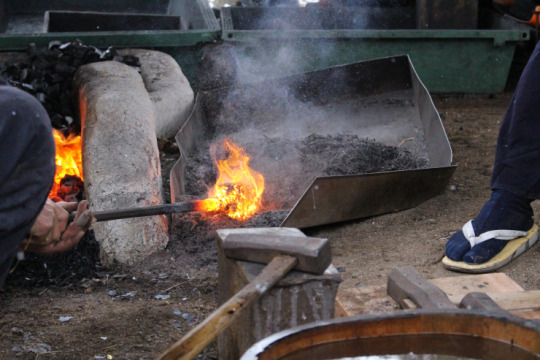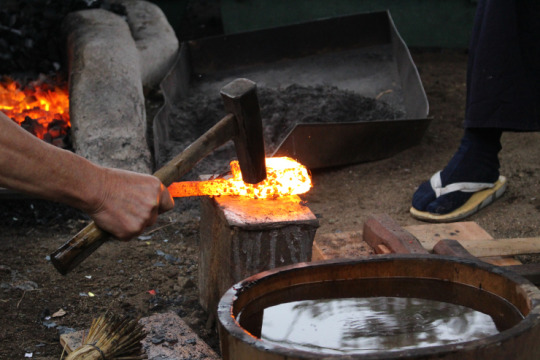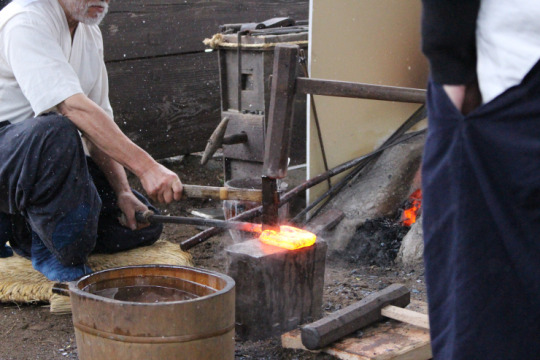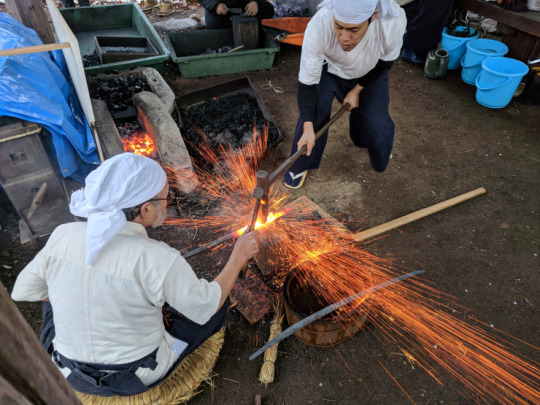#sensei shah
Text
Brynne Headcanon:
I am convinced that Brynne didn't just get her muscles and strength from just Bhima and training alone. Gunky and Funky had to have pulled a Mr. Miyagi on her growing up and made her stronger through helping with the cooking. Anyone who has made or helped make Indian sweets know that the sheer time and effort it takes makes it a workout in its own right. You cannot tell me that Brynne's biceps didn't explode every time she spent like 15-20 minutes mixing Peda (basically like caramel that hardens into fudge). She probably has a workout routine that looks something like this:
Warm up wrists by mixing potted butter with the classic string and stick
Weight train by bringing in groceries like bags of flour, rice, etc.
Do more wrist training by prepping ingredients: mixing flour and water to make roti dough, washing rice, cutting vegetables/meats, etc.
Then practice punching motions as you roll them flat
Strengthen biceps by mixing curries, sweets, etc in the pot because the second you go too slow, it'll catch and burn
Focus on breathing and endurance as you work over a hot stove with steam flying in your face
Focus on precision and timing as you look at fine details to know when everything is ready
Finally, a break! Time to C O N S U M E
#aru shah#aru shah headcanon#aru shah headcanons#brynne tvarika lakshmi balamuralikrishna rao#mr.miyagi is the sensei in karate kid#wax on wax off
26 notes
·
View notes
Text
Translation Question
As responses seems to have a character limit, I'll post any responses to questions here which are too long otherwise. In this case, the question was why we went with "Shahpur" as a title for Arslan when there is a character with basically the same name. So, here it is!
When we started the translation over a year ago, there was a long talk about the fact that Tanaka-sensei used a smattering of Farsi, English and Japanese for titles when referencing those who had one in the book and whether to leave it that way or not. Eventually, the decision was made to default to Farsi and older Persian words whenever possible, so as not to have things all over the board.
After some looking, we found a few terms for ”crown prince," the generally accepted translation for "denka" even though the direct translation of "denka" is more along the lines of "his/her highness." Shahpur was among the options. Knowing the character existed this became another long discussion. After a time, we decided that using "Shahpur" for the title still worked best, despite the overlap, for a few reasons:
1. It is closest to other used titles, such as Shah or Padshah.
2. Shahpur" is literally "son of the king/king's son" and, although used also as a name, it is suggested that it began as a title when we researched. "Shahzadeh," on the other hand, is gender neutral and can be used for any descendant. So we opted to used the masculine version in this case.
3. There are several spellings to the name. As Shapur, the character, is a minor one, we decided go use "Shahpur" as the spelling for the prince and will be using "Sapor" for the character in an effort to bring about less confusion when he is mentioned.
6 notes
·
View notes
Photo

. 🎍明けまして 🐯おめでとう🐯 ございます🎍 保護仔猫さわちゃんは 冒険心いっぱい❣️ ケージからの脱走を繰り返しています。 先住保護猫のルナ先生は そんなさわちゃんに ハーッ💢 フーッ💢 シャーッ💢 イヤイヤ… そんなんじゃラポール形成できないよぉ〜😂 と、にゃんこから学��を得る2022年の幕開けです。 今年もにゃんこズ共々 どうぞよろしくお願いいたします🙇♀️ .. 🎍 Happy New Year🎍 🐯 Protective kitten Sawa-chan Full of adventure ❣️ Repeated escape from the cage. Luna-sensei, a native protection cat treats to Sawa-chan Hah 💢 Whoops 💢 Shah 💢 Oh no... That's why she can't make friendships ~ 😂 It is the beginning of 2022 to learn from cats. Cats and I together this year 🙇♀️ #パステルアート #パステルなごみアート #pastelart #pastelnagomiart #pastel_nagomi_art #粉彩 #和諧粉彩 #和諧粉彩正指導師 #まみぃずほーむ #mammys_home #zoomレッスン #zoom_lesson #english_ok #englishok #結晶の花 #結晶の花パートナー校 #flowerofcrystal #結晶之花 #flowerofcrystalartacademy_partnerschool #パステリア書 #pasteria #noir_art #silhouette_pastel #アトリエmomo #atelier_momo #パステル宇宙アート #pastelcosmicart #保護猫 #保護猫と暮らす https://www.instagram.com/p/CYLqbMNr0I5/?utm_medium=tumblr
#パステルアート#パステルなごみアート#pastelart#pastelnagomiart#pastel_nagomi_art#粉彩#和諧粉彩#和諧粉彩正指導師#まみぃずほーむ#mammys_home#zoomレッスン#zoom_lesson#english_ok#englishok#結晶の花#結晶の花パートナー校#flowerofcrystal#結晶之花#flowerofcrystalartacademy_partnerschool#パステリア書#pasteria#noir_art#silhouette_pastel#アトリエmomo#atelier_momo#パステル宇宙アート#pastelcosmicart#保護猫#保護猫と暮らす
0 notes
Text

A few days ago I had the amazing opportunity to meet, speak with, and watch the famous Japanese blacksmith Masahira Fujiyasu work during a special event at the Minka-en grounds in Fukushima City, thanks to the hard work and planning of Andy Coombs and the Fukushima City Tourism and Convention Association. This type of event hasn’t been held for over a decade and the majority of Japanese people never get this opportunity, let alone a foreigner. Mr. Fuhiyasu’s master was a national treasure of Japan and I am told that Mr. Fujiyasu is the last classically trained blacksmith that has mastered techniques of making Kamakura and Muromachi period styled blades. What added to this even more was the opportunity to speak with him and his students during lunch and while he was taking a break in the afternoon.
We arrived at the forge around 10am to find Mr. Fujiyasu finishing his preparations for the day. He made a forge and billows there just days before. It was interesting to see as it had two air inlets with flaps that would alternate as he pushed and pulled to create a constant stream of air to feed the hot coals, reaching temperatures of 2700 and above, depending on which stage he was at and how hot he wanted it to be.
Seeing as we only had about 6 hours for the event he decided to work on a few swords at different stages of the creation process to give a better understanding of the Japanese sword creation methodology. He had already prepared the tamagahane and placed it in a concise pile to be inserted into the hot coals.

After removing the white-hot steel from the coals he would roll the block in a pile of ashes and quickly begin the hammering process.

While he worked, one of his students would help hammer, while the other would quickly cut the charcoal into specific sized chunks, in order to maintain a consistent temperature. They would switch out once in a while, and during a certain stage they both worked to hammer at the same time.

After a while Mr. Fujiyasu started folding the steel. He folded it not only in half vertically, but at least once horizontally as well. To do so he used a wedge to partially split the molten steel, then he would slowly hammer it as he rotated it on the anvil.

After several folds (and a few hours) everyone took a lunch break. We had some delicious hot Soba, Udon ,and onigiri as everyone relaxed in the warmth of the space heaters.
Here I was able to speak with Mr. Fujiyasu a bit and discovered that he was an avid Kyuudou practitioner and he felt that it was an important part of his life. We discussed martial arts, and the swords he would be working on for the rest of the day. He said he would be working on a kogatana (short sword) and a katana (long sword).
When he said “kogatana” I asked if that was the same as a wakizashi, or maybe a tanto. He said that in the time period he specializes in, they didn’t use the term wakizashi yet, so shorter swords are generally referred to as just kogatana. If the length was compared to modern standards, it would fall roughly into the size of a wakizashi, but on the long end. The katana he worked on was to be 2 shaku 4 sun in length.
Terms such as shaku (shah-ku), sun (soon), and bu (boo) are still used today to reference sword length. 1 shaku is about 30.3022 cm (or 11.9303 inches), while a sun is 1/10 that of a shaku (3.03022cm / 1.192999in), and a bu is 1/10 that of a sun (0.303022cm / 0.119299in). If discussing cloth length, the measurements change would slightly.
So the length of the katana he would be working on should be about 72.725cm (28.6319in) from the tip of the blade to where it meets the metal collar mounted between a sword blade and the hand guard (habaki). That’s about the same length as the blade that I use for Iaido training…so I was looking forward to seeing the outcome even more.
From here Mr. Fujiyasu skipped about 2 days of the folding process by taking out the blades discussed above, that he had worked on at his personal forge. The blocks had been formed into long rectangular rods

and he started to hammer them into his general desired shape. He would often splash water under the blade as he forged it, creating loud booming sounds as he struck.


Here is the end product for this stage.

From here he would continue to work on the blade for several more steps, such as a rough shaping (7th step), cleaning with a slurry (8th), tempering with the slurry after being heated to the desired temperature (9th, often at night or in a fully enclosed and dark place to better see the color of the flame and sword). Here, Mr. Fujiyasu must decide whether the sword was a success or a failure. If it’s a failure, it will be scrapped and he will have to start the process over from the beginning. If not, he moves on to filing the blade to his desired thickness and to straightening any light bends in the blade. Then he will also use an arato whetstone (~200 grit), bringing the blade to what I am holding in the photo below. (some lovely hat hair included)

At this point Mr. Fujiyasu took a break between shaping the two swords and came over to speak with me about the katana I was inspecting. This is a sword that he had finished a few days earlier and we talked a lot about the shape as it had a strong curve for such a long sword. From our earlier conversation he knew that I practiced Iaido and asked me a few questions about the blade to see if I could guess the length, weight, and a few other aspects. It was almost exactly my size and he said I was right on the mark! We then discussed a few other details and what else was needed for the blade to be completed. For this one, it still needed to be handed off to a profession sword polisher and to have his name and place of creation inscribed into the tang. I was having a blast as he is a really energetic older gentleman. I hope I have the please of speaking with him again soon.
Unfortunately we couldn’t stay until the end as the group we were with was scheduled to leave, but we were showed around the Minka-en and saw a few of his completed works, some traditional buildings and workshops, and even an old theater with a massive rotating floor.
This was an absolutely amazing experience and this certainly doesn’t do it justice. In a week or so, I should have a video up here so you can see everyone in action as well. If I’m lucky, I might be able to order a custom made katana from him next year! That’s still a long way off and I would need to have in-depth talks with him as well as my sensei, but just the thought is enough to send me back to the dojo with even more energy than usual!
The event was covered by the prefectural news station (NHK TUF) and here is a short clip from that coverage (in Japanese starting at about 21:06).
Note: I am not a blacksmith and the entire event was conducted in Japanese with some interpretation services from Mr. Coombs. It is quite possible that I misheard some of the information and that could result in an incorrect use of terminology in this post. If you see something that should be corrected, please feel free to comment below in order to let me know.
*Thanks Tito for a few of the photos used above!
Making of the Katana: Behind the scenes with a Master A few days ago I had the amazing opportunity to meet, speak with, and watch the famous Japanese blacksmith…
#adventure#art#blacksmith#Business#cold#福島#design#Epic#鍛冶屋#famous#fire#forge#Fujiyasu#Fukushima#fun#Japan#karate#katana#kyudo#life#make#martial arts#Masahira Fujiyasu#master#me#metal#mindofrion#mindofryan#NHK#opinion
0 notes
Photo

It’s been a busy March, as Mobile World Congress dovetailed right into SXSW, just a week later. This year I thought I’d write up high-level learnings from both, as digital and tech professionals continue to fight to keep up with the frenetic pace of our marketing and cultural landscape.
Overall, my observation is that we are well on the way toward building the foundation for the Fourth Industrial Revolution. The way that we will live our lives in the next 100 years will make our current day lifestyles look incredibly archaic. However, instead of delving into predictions of the macro changes in civilization and world economy – I’m going to focus in on what marketers can find most useful. Are you ready? Here we go.
Application to Person (ATP) infrastructure is in development.
The digital marketing evolution is as follows: In the 2000s, we interacted with consumers through laptops and browsers, in the 2010s it has been through phones and apps, and in 2017 we are seeing the dawn of messaging and bot interaction.
Why now? According to Dharmesh Shah, Founder and CTO of HubSpot, the reason why it’s happening now is that: 1) AI and natural language capabilities have rapidly improved, which allows us to do things we simply could not even 2 years ago, and 2) the human adoption of messaging is there, so we already have platform with scale waiting for great applications.
"Bots are the most important advancement in the last 20 years." - Dharmesh Shah, Founder and CTO of HubSpot
As I listened to various experts, including entrepreneur Chris Messina, the consensus is that bots will not replace sites, rather they will augment them. We are still in very early days, with the biggest problem being discoverability. In other words, how will consumers find your bot, and how will they understand what it can do?
For brands ready to dabble in this space (which I highly recommend), my advice is to start simple, think about how to on-board your customers, and make your bot the shortest distance between their question and your answer. Most of the branded bots today are rudimentary, similar to the first websites online (remember what Amazon used to look like?), so it’s a good time to experiment while expectations are low. Most brands are focused on bots as it relates to service. If your bot is powered by AI and you release too early, what happens to a brand if that bot goes rogue? Start simple.
However, interestingly one of the most popular bots to date has been a “chit chat” bot. Mitsuku gets a few hundred thousand queries a day and can be accessed via Skype. She can tell jokes, tell you stories, play games and argue. It’s an early example that shows how a brand could start to bring to life a personality – which in the future should include text/speech to visual response (i.e., chart, video, audio) and feature branded acoustical design (i.e., voice, sounds).
Another thing to keep in mind is that most companies just don’t have the stack to support a sophisticated multi-modal approach (i.e., deployed across site, messaging chatbot, and voice/IVR). To do this, a company needs to have one database and un-siloed content, (Adobe is working on a solution, called Sensei). If you haven’t started to plan this out – start now.
In addition, it’s important to note that everything in this ecosystem is being developed right now, including: adtech, content tech, data tech, analytics tech, commerce/payment tech, and basic standards (i.e., XMPP and APIs). One major difference in the development in this area is that, unlike the democratization of the open web before, the silicon monoliths are much more in control as they hold the keys to natural language and deep learning processing, among other things. And companies like Google and Facebook are working furiously on tools for developers, but again, it is still very early days. I also hear rumors of Facebook working on a metabot of some sort, which could serve as a search engine or be a bot that represents your interests and talks to all other bots – a super bot. Imagine a bot that learns how to interact with you, instead of you learning how to interact with a site or app. In developing nations, we are starting to see another pattern of interest, which is - just like consumers skipped the laptop and went straight to phone, it looks like they may skip the internet and go right to bots for brand interaction.
Hopefully you find all of this useful as you start to think about how to evolve from the click, to the touch, and into the conversation.
The Autonomous Vehicles (AV) industry is arriving sooner than you think.
So BMW was the first to put a SIM card in the car, and they now have 8 million connected cars. As a brand, it’s interesting because if you’ve positioned yourself as “The Ultimate Driving Machine” and in the near future people may not be driving – what’s the pivot?
Well, according to BMW, the pivot is to move from the car at the center of the strategy to the person at the center, and to become an internet company. And then, to redesign the interior concept and focus on the car as a platform. Lastly, to start to diversify the finance business strategy, as personal car loans start to decrease in the future.
I heard similar sentiment from Ford, which seems to be thinking about positioning as a transportation partner. I start to envision car companies with fleets where you can buy a subscription service, with different package levels. This would make car companies more like direct competitors to Uber. Make no mistake, every single car company is well “down the road” planning for this – with BMW promising its “Intel inside” fleet starting this year.
Like the ATP infrastructure, the AV industry infrastructure is very much underway. For example, Qualcomm unveiled their Drive Data Platform which will be able to collect and analyze vehicle data quickly, and their Snapdragon 820Am (automotive processor).
But another layer necessary to bring this to life is mapping technology that is accurate down to the centimeter. Thus, HD map making data is coming from companies like TomTom. And others are joining the mix, like start-up Sensat, a company from a civil and nuclear engineering perspective, that can “digitizing the world” – essentially creating a "copy" of the world with ones and zeros, tagging everything physical down to centimeter accuracy.
After that you’d probably need another key variable to be sophisticated – weather. And of course, companies like AccuWeather are investing in their MinuteCast data to provide minute by minute detailed information (i.e., rain intensity), now mile by mile so that they can provide this information back to the car companies. Imagine, “…you are approaching black ice in 3, 2, 1”.
Another layer that is necessary is uber-fast connectivity, so that we can enable V2X communications – think vehicle to infrastructure (i.e., smart city), vehicle to vehicle, vehicle to pedestrian, vehicle to media, etc. The Telecom companies are now significantly investing in 5G to dramatically improve speed.
And so, you can start to envision a reality that is not too far in the future. Manik Gupta, Head of Product & Maps at Uber talked about maps as essentially a data ecosystem that also contains ETA (based on traffic, road closures, speed), routes, fare commerce – all in the “map”. From a cultural perspective, he mentioned in a session that if you have 2 billion cars on the road, and every car was shared, we’d only need 10% of the cars we have today. He said, “If you think about it, 96% of the time, your car is sitting idle. And, 10% of millennials have either given up or have not even bought a car.”
So if that’s true, it starts to paint an interesting future. Imagine what we will do with all of the empty parking lots? Maybe turn them into green spaces or allow our cities to become denser as it opens up real estate opportunities. And what will we do with our garages? But further, it starts to show the level of massive disruption around the car industry and adjacent industries. Take for example the insurance industry. What will happen if risk of vehicle injury or death is reduced dramatically, and individual car ownership decreases significantly?
The Artificial Intelligence (AI) revolution is the underpinning.
At this point, you’re starting to get a sense of the massive shifts we will be experiencing in the near future. And of course, both of these developments are possible because they will be built on an AI layer. However, AI is such a huge topic, it will need to be its own separate post. Instead I’ll include a few takeways I found particularly interesting.
One keynote I listened to was Son Masayoshi, the CEO of SoftBank. In his talk, he mentioned that he will be putting together $100 Billion in investment money specifically set aside for AI, and to put that in perspective the entire venture capital value worldwide is approximately $65 Billion.
“I’m doing this because in 30 years, AI will surpass mankind intelligence. Imagine that the average IQ is 100, and the hardware of our brains will not increase. But in 30 years, AI will have the equivalent of a 10,000 IQ. It will fundamentally change our lives in ways we cannot imagine. And we will need an entirely new infrastructure – in chips, security, and fast connectivity.” - Son Masayoshi, CEO of SoftBank
You can watch his keynote here; I highly recommend it. As I think about the impact, just like the car industry, advancements in AI will start to transform and disrupt many other sectors. And so, the Fourth Industrial Revolution begins.
Conclusion
At Mobile World Congress and SXSW, there were so many other specific topics covered, like Rich Communication Services (RCS), Security through Biometrics, and Mesh vs. Cloud… but perhaps I’ll cover those in the near future. The upside of the significant changes discussed here are the immense B2B2C and B2B2B2C opportunities abound as these new industries emerge.
And there were plenty of interesting creative advancements too. Like how Disney intends to use all of these new applications to create magic for their fans. So with that, I’ll leave you with a quote from a long-time Disney employee.
“This is going to be a decade of staggering innovation." - Jon Snoddy, SVP of Walt Disney Imagineering R&D
I agree.
0 notes
Video
youtube
Sensei shah - "Bout' Me"
0 notes




